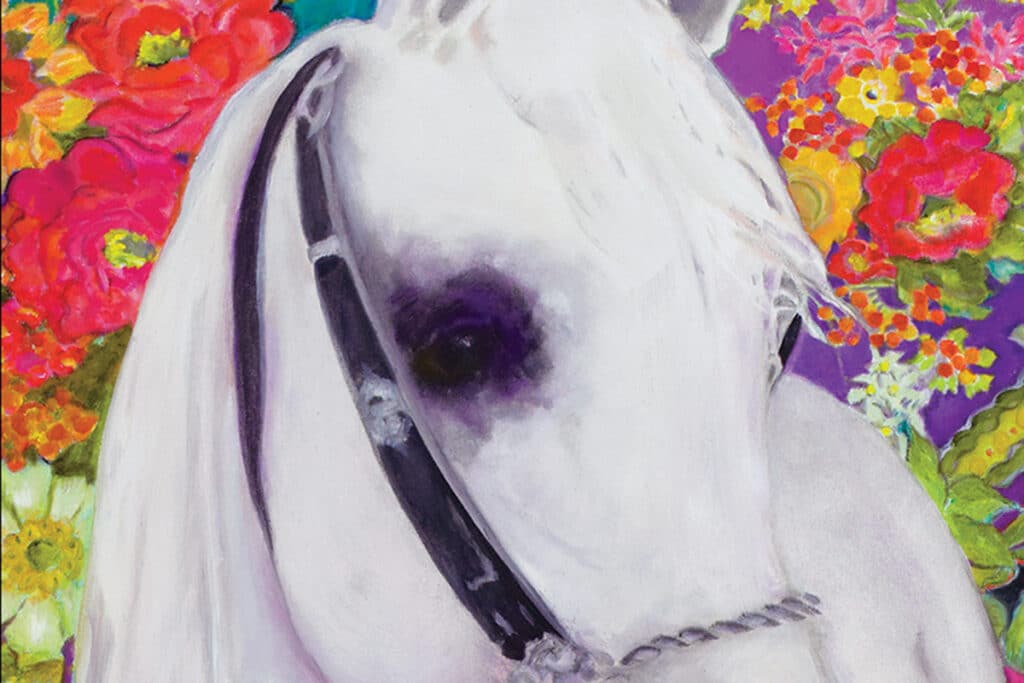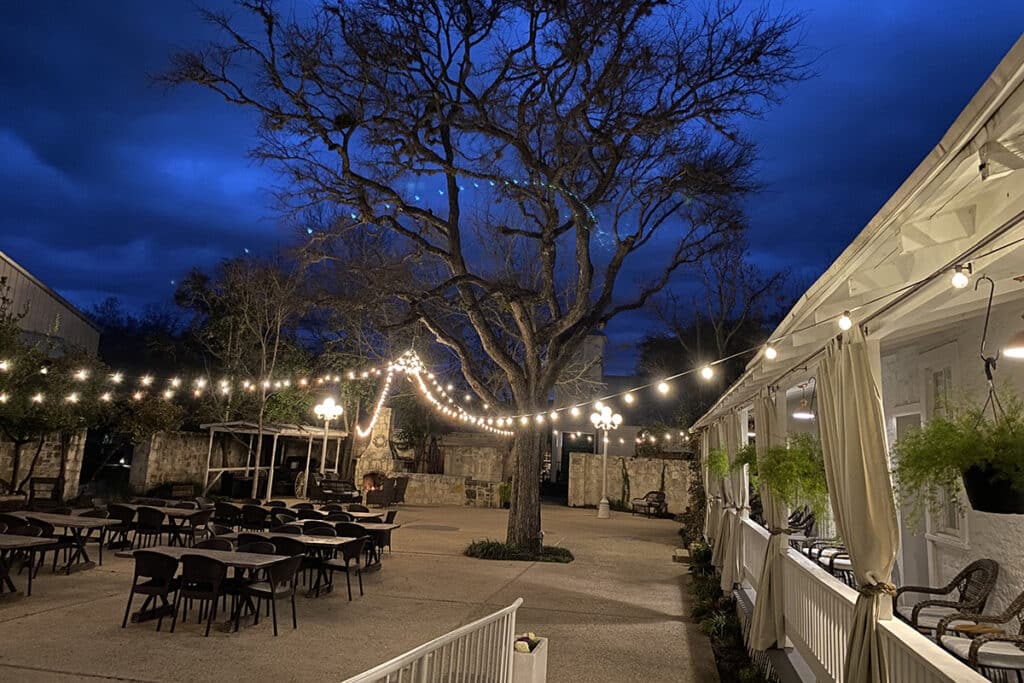Art aficionados who flock to the Blue Star Arts Complex on big opening nights are always pleasantly surprised when they pass by the Marcia Dahlman Pottery. Even if they don’t step inside to look at the eyecatching jars and wall pieces, they can’t help being attracted to the graceful little fountains that gurgle ever so enticingly just in front of her door. Invariably, people stop to admire her handiwork.
Having a studio/gallery at Blue Star is an advantage for any artist, but for Dahlman it happened through a lucky, serendipitous turn of events. When she got there in early 1985, the complex was far from hip. The only reason it was on her itinerary at all was because a clay company was located on the premises.
“I bought my clay from them, so I knew that all the area upstairs was open and empty,” recalls the artist. “;Two of my artist friends and I decided to build our studios in here. We didn’t think of it as a retail space, we just wanted studios. Then, six to eight months later, the Blue Star developers bought it and kicked the clay company out. They almost kicked us out, too, because at first they hoped that design and architectural firms would move in. It didn’t happen. The roof leaked, the place was a mess back then. It wasn’t hip at all. Eventually, it developed into an art place but only very slowly. Now, it’s good to be here.”
Today, she shares a building with a bunch of other artists, plus respected, small contemporary galleries such as StoneMetal Press, Three Walls and Cactus Bra Space. Still far from polished, the building’s rough interior announces itself as a place where people work with their hands. And that’s certainly true of Dahlman’s premises. Her studio is crammed with tools, equipment and work-in-progress. There is no doubt that real work is going on here. Two tables are covered with painted tiles to be used for a neighborhood project in Mahncke Park, where she lives. Under her leadership, a group of artistic residents have decided to cover the retaining wall on New Braunfels Avenue, between Funston and Pinckney, with a tile mural they call The River of Time.
“;I would like to get more into tile installations,” says the artist as she shows us around the studio. “;Community tile projects are a fun way to get people involved. For this one we got a small grant from United Way, but we hope to raise some money from neighborhood businesses, too. We are going to need 1,100 tiles.”
More tiles may be in her future, but what Dahlman is best known for at present is raku-fired pottery. Examples of it adorn the little gallery that fronts the studio — vessels, boxes, masks, fertility figures, “;maps” and “;musical instruments,” none of which looks like traditional pottery.
Raku — which loosely translates as enjoyment or pleasure – was first developed in Japan in the 16th century as a method of firing earthenware bowls for the tea ceremony, hence the connection with enjoyment. The technique involved rapid heating to melt the glazes, followed by a quick cooling. The first Westerner to observe the process, Bernard Leach, was astonished that the pots did not break despite the extreme stresses imposed on the material by the abrupt changes in temperature.
Once raku made it to America in the mid-20th century, it was enriched and modified by various practitioners to achieve a greater range of aesthetic effects. Dahlman discovered the process back in 1988 in a class at the Southwest Craft Center and adopted it immediately as her own. She starts by buying special raku clay formulated to minimize cracking and uses only raku glazes. Two of her favorites, which she often applies together, are Piepenburg Patina and Matte Pink because she likes the colors they produce and the matte finish.
After forming her pieces and designing surface decorations, she first subjects them to a preliminary firing in an electric kiln and allows them to cool before applying the glaze. “Then, I have to carry them home for the raku firing because it’s a very smoky affair,” explains the artist. “;I do it outside in the yard.”
She places the items in the raku kiln and fires them until the temperature reaches 1800°F and the glazes “;mature.” At that point, the colors look rather drab. In the next step, the pots are pulled out of the still hot kiln and transferred quickly to the “;reduction chamber,” which consists of a metal trash can lined with newspapers or other combustible material. Under these circumstances, the newspapers catch fire as they come in contact with the pots, while glazes undergo a reduction process, meaning their chemical structures start to lose oxygen. The can must be covered tightly to prevent air (oxygen) from coming in. It is during this last phase that a spectrum of beautiful colors develops, from coppery reds and magentas to pinks, pale blues and golds. (Yes, there is some complex chemistry going on here!)
Needless to say, one must be pretty careful around all that heat and fire. “You have to wear a welder’s type of face protection,” says the artist. “;There is a joke that raku potters have no eyebrows, but I have never had an accident.” The results of her labor are objects with multicolored textured surfaces that look like antique abstract 3-D paintings. At first glance, you may also think that they were made out of copper metal which oxidized unevenly in a particularly fanciful way. Since the colors develop differently, depending on a number of factors, including the amount of available oxygen, the final effect is always unpredictable. And that’s exactly what appeals to Dahlman.
“;Part of it is the challenge because it’s hard to get those colors, but the bigger part is the unpredictability of it because you never know what you are going to get,” she says. “;It’s like Christmas each time you remove the pots from the can.”
HER TRUE CALLING
Growing up in Chicago, Dahlman, 60, never thought she would become an artist. In high school, she had set her heart on a career in nursing, and that’s exactly what she pursued for quite some time. When the military relocated her young husband, Dirk Dahlman, to San Antonio, Marcia came with him and never left.
“;I did nothing artistic other than a little poetry until I was in my early 30s,” she says. “;That’s when some friends decided to take a clay class at the (San Antonio) Art Institute, and they said,”Why don’t you join us?’ The minute I touched clay I thought, “This is what I want to do when I grow up.’ It was like a coming home experience.”
But she couldn’t quit nursing right away. Dirk had left the military and was pursuing his graduate studies, which meant Marcia was the breadwinner in the family. The marriage eventually dissolved, but her love for clay flourished. She continued to take classes for three years and built herself a studio in her garage. A short time later, she met a new life partner, a man she will identify only as Ed, who “;made it possible for me to become a full-time potter for 16 years.” With Ed, Dahlman traveled throughout Europe visiting ceramicists, galleries and museums from Ireland and Holland to Spain and Greece.
“;I had an immediate facility with throwing clay,” she says, looking back at her early years. “;I just loved the idea of making useful, functional items. I was a functional potter for 10 years, went to fairs to sell my wares, and made money. But I got tired of it. That’s when I took that class at the Craft Center to learn raku. I wanted to do something different, more decorative things.”
For her often complicated forms, she looks for inspiration to contemporary jewelry, which comes in all kinds of shapes. “;It speaks to me about space,” she says. But she also gets ideas from the masks of Oceania, from African fertility figures she saw at the Smithsonian, natural elements, Southwestern themes and from her fascination with maps. In her interpretation, the latter turn into fractured globes “;with raku-colored continents floating on them.”
Since 1986, Dahlman has participated in numerous juried and other exhibits, won awards and had her work featured in Clay Times and American Style magazines. Both private collectors and corporate ones, such as USAA and Intelogic Trace Corporation, own her work. And for years, sales were brisk.
These days, however, the wobbly economy makes people watch their money carefully, she says. As a self-supporting artist, she is mindful of that. While her more sculptural fertility figures cost several hundred dollars, small items are often priced under $100. In addition to rakufired items, Dahlman also makes the aforementioned high-fired stoneware fountains, which are not only attractive but very functional indeed.
To survive through leaner times she works seven days a week in the studio and had to return to part-time work as a research associate at the Health Science Center recently. Yet a sign on her “;inspiration wall” proclaims that “;No one ever looked back and wished they spent more time at work.”
When we draw her attention to it, she immediately protests: “Oh! Making pottery is not work. If I could just do pottery and travel, I would be happiest.”
Author: Jasmina Wellinghoff
Photographer: Janet Rogers




